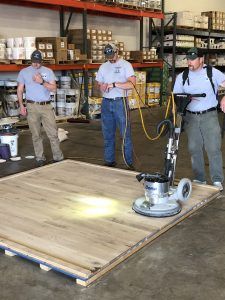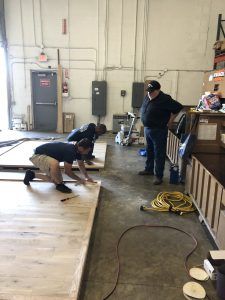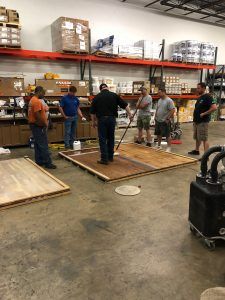Blog#1: “Acclimation”
If we are all honest every one of us has heard some of the following:
*I left it in the house for 72 hours! UNDER WHAT CONDITIONS?
*I opened the ends of the boxes, that’s acclimation, right. DON’T…STOP!
*We acclimated the floor in our conditioned warehouse! WHAT ABOUT THE JOBSITE?
*We acclimated it from the van into the house! I DON’T EVEN NO HOW TO REPLY!
*Acclimation, what the heck does that mean, I’ve been installing for 30 years, never had a problem, it’s YOUR wood…….YES SIR, that’s correct, Chet grows the trees, Dave’s boys log them in their spare time and Rick has a full milling/finish line in his garage!
Really, as misunderstood a topic, it’s not “Rocket Science”. NWFA Installation guidelines, Appendix B Acclimation: ….Wood flooring simply needs to reach a moisture content level in equilibrium with the surrounding environment in which it will be installed, at or near normal living conditions. The point of acclimating wood flooring before installation is to allow the moisture content of the wood to adjust to the installation site’s “NORMAL LIVING CONDITIONS”
Science: Wood flooring both solid and engineered is both hygroscopic and anisotropic. Hygroscopic material will gain or lose moisture till it reaches EMC (equilibrium moisture content) in relationship with the RH (relative humidity) and temperature of the surrounding air. Wood expands when it gains moisture, and shrinks when it loses moisture. Dimensional Change Coefficient (as published by the USDA Forest Service) numerically labels this expansion/contraction by wood species per unit change in the MC of the wood. Because wood is also anisotropic, it does not shrink and swell equally in all directions. In plain sawn material (majority of wood flooring produced) shrink and swell tangentially (in width) is double or greater radial or longitudinally. In lay terms, failure to consider and properly acclimate prior to install can lead to cupping, compression set, subsequent permanent gapping, face checking and with engineered material veneer splits and end joint edge curl.
Real world: each and every situation differs but a common thread of good practices should be developed by installers to insure the most successful install with minimal callbacks. Acclimation is about product, geography and time of year. Wood flooring should be installed as late in the building schedule as available. Permanent HVAC (local building codes prevail) should be operational a minimum of two weeks prior to delivery. Tools necessary for this part of the job include a moisture meter and a thermal/hygrometer. Prior to delivery jobsite conditions need to be checked for proper conditions. OSB and/or plywood subfloor should be checked with a moisture meter and if readings taken; 12% and under, acceptable, 10% and under ideal. Ambient site conditions should be checked on each level including the basement and crawl space. As an industry “wood’s comfort level” is 35-55% RH. Product exposure under and over these RH readings can have adverse effects on the installation. Please understand I am sympathetic to building site conditions and am fully cognizant that these RH conditions are difficult to maintain in new construction. But it is important to look for anomalies. A basement with RH readings in the 70-80% RH range (not unusual in new construction) should be addressed for the most successful install. Once wood is delivered its time to use that moisture meter again but this time to check, record and draw a base line for the flooring’s MC. Our industry recommends this base line is drawn on a minimum of 40 board readings per 1000Sf material. Readings should be from random cartons and levels in nested bundles. As blanket/general rule our industry recommends wood flooring and subfloor differ in MC readings no more than 4% if the board width is under 3” and no more than 2% difference if the material is 3” and wider plank. BUT that’s where it gets a little fuzz, because consumer lifestyle and installation geography now come in to play. As example; shore location installation, 5” wide plain sawn plank flooring, February installation. The subfloor is at 9% MC average, wood flooring 7% MC average, GREAT I’m good to go, correct? Frankly, probably not for a long term stable install. It’s about geography! The expected EMC of material installed in this geography could be in the 11-13% year round. Unless you are absolutely certain (and frankly absolutes don’t exist) the contractor should consider acclimating the material for a higher average MC prior to installation.
So, proper approach to acclimation. DON’T set the material on site and rip the end flaps off the cartons. The only thing you will achieve is potential width variation of the boards abutting those open end flaps. DON’T store material in unacceptable conditions or locations. DO try to achieve even air flow between materials. Ideally, the best way is similar to the practice of air drying boards. Individually stacked rows with kiln dried sticks between rows. Ok so being a realist, what are the chances of this being done, probably none because slim already left the room. As a good alternative material should be stacked like cord firewood with space between rows. If material is in cartons open completely, that’s better than alternatives. Again using your moisture meter make dated random checks till material has reached acceptable MC for the installation.
Lots more could be discussed on this topic but my blog is to try and help not overload the topic. Thanks and I welcome your comments and thoughts.



 Apply for Credit
Apply for Credit Customer Login
Customer Login







